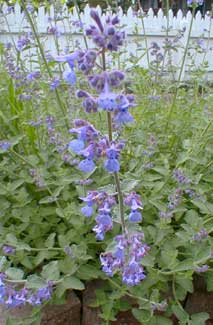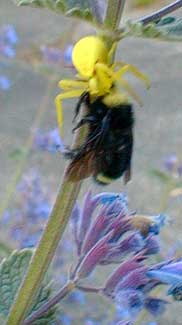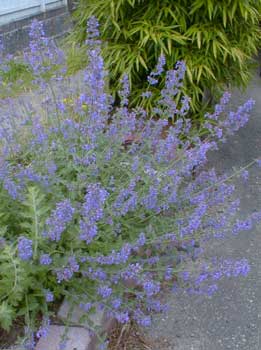
'Walker's Low'
Persian Catmint
"Time got his wrinkles reaping thee
Sweet herbs from all antiquity.""
-Sidney Lanier
(1842-1881)
(1842-1881)
At the head of the alley opposite the garage there's a little area of ground where it would be folly to plant anything important, because first of all it's not easy to get water up to that corner of the property, & mainly there's the problem of people who use that alley taking the corner not sharp enough hence apt to run over plants.
 But I can't stand a plantless bare patch, so I put a couple of extremely drought-tolerant perennials up there, including Russian Sage (Perovskia atriplicifolia ) & 'Walker's Low' Catmint (Nepeta racemosa, formerly N. mussinii).
But I can't stand a plantless bare patch, so I put a couple of extremely drought-tolerant perennials up there, including Russian Sage (Perovskia atriplicifolia ) & 'Walker's Low' Catmint (Nepeta racemosa, formerly N. mussinii).The catmint has crinkly grey-green foliage which upholds spikes of lavender-blue flowers that have their first flourish May through July, reblooming deep into Autumn if deadheaded or sheered on top a couple times through the seasons.
Some species & varieties of catmint are a bit floppy, but 'Walker's Low' either
 stands sturdily upright or at maturity fountains evenly & requires no support. It remains relatively short & compact at around fifteen inches to two feet, occasionally taller, but with a wide spread to the point of being rampant, very easily to a two-foot wide clump & eventually becoming a considerable expanse of groundcover.
stands sturdily upright or at maturity fountains evenly & requires no support. It remains relatively short & compact at around fifteen inches to two feet, occasionally taller, but with a wide spread to the point of being rampant, very easily to a two-foot wide clump & eventually becoming a considerable expanse of groundcover.Its spikes of blue flowers are loved by bees & other pollinators. The second May photo shows a hapless bee captured by a yellow crabspider, such as classic entomologist Jean-Henri Casimir Fabre (1823-1915), in his book The Wonders of Instinct likened "the comely Spider who cuts Bees' throats." These crabspiders usually hide in flowers that match them in color. This one seems not to have noticed the nearby patch of Allium moly luteum in full bright yellow bloom not six feet away.
It is not quite as aggressive as many a Mentha species of mint, but heading in that direction. But having those wonderful bright flowers such as mints all but lack, catmint is more welcome to spread.
The foliage is wonderfully scented & useful for dried potpourri or added to fresh bouquets in order to bring a spicy garden scent into the home.
It wants full sun & in our zone needs next to no watering except in the droughtiest times of summer. A native of Asia Minor, it found its way into English gardens as early as 1804. In Greece it is called Oenothera, "wine-taste," alluding to one of the traditional uses of its roots, as it was long believed that to chew the roots would render a mild mannered individual fierce & bold, like a wild drunkard.
This species & more so Nepata cataria are the source of "catnip" that intoxicates house cats, & can be dried & sewn into cloth cat toys. Because cats are attracted to it. Catmints were traditionally planted around barns in the belief that the plant itself was a rat repellant, rats presumedly understanding that where there is catmint there could well be cats. Rats are pretty smart, so maybe there's something to it.
The cat intoxicants have a mild sedative effect on people, so that catmint is sometimes used in lieu of chamomile to assist sleep, though frankly chamomile, valerian, or hops would be better choices for such a purpose.
Newly set plants are bound to be bruised at first, releasing the scents that attract cats, who have been known to completely destroy unprotected plantings by leaping & rolling in this herb, tearing & chewing in extreme delight. It is sometimes recommended to protect the plants from cats with a cage or barrier. But cats have not bothered our planting, which is perhaps too close to the road for cat relaxation.
Crushed or powdered leaves, & the essential oils from this species, as from other catmint species, have been used medicinally for a variety of purposes, including to treat colic, toothache, menstrual cramping, convulsions, dyspepsia, flatulence & diarrhea. It has been used as a deworming agent, to treat the common cold, in the form of ointment to reduce swelling of hemorrhoids, & as a shampoo for empentago or scurf. Catmint enemas were believed to reduce fever.
Culpeper believed drinking it with wine stopped bodily bruising, & Grieve believed that made into a conserve it could be eaten as a cure for nightmares. Most of the numerous alleged values are highly debatable, a few are not even marginally likely, though it does have an undeniable antioxidant & astringent effect. That catmints do indeed impact the body chemically is certain, whether to any healing benefit is another matter.
Active ingredients include Nepetaracemosides A & B, nepetalic acid, vitamin C, & iridoid glucosides, among others. It can be used steeped as a tea, though active boiling breaks down chemical components. The young leaves are suitable in soups or salads.
'Walker's Low' was selected as one of the five best plants for Northwest Gardens by the Great Plant Picks committee in coordination with the Miller Botanical Garden.